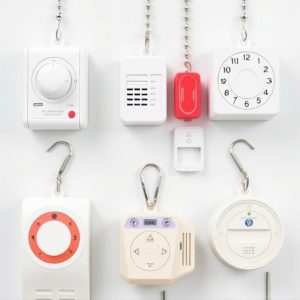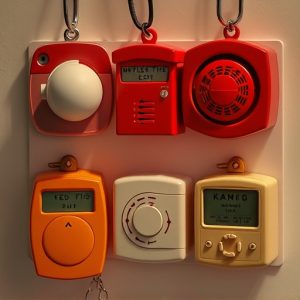Protecting Solo Travelers: Essential Electronic Safety Devices and Features
Solo travel enhances freedom but demands heightened security, making personal alarms essential tools…….
Solo travel enhances freedom but demands heightened security, making personal alarms essential tools. These devices utilize powerful sounds to deter threats and attract help within specific personal alarm sound coverage areas (typically 30-100 meters). Advanced models incorporate GPS tracking for real-time location sharing with contacts, crucial in areas with limited network coverage or unexpected delays. Features like adjustable noise levels, automatic fall detection, and water resistance offer versatile safety solutions for both urban and remote solo travel adventures.
- Understanding the Need for Electronic Safety Devices While Solo Traveling
- Types of Personal Alarms and Their Effective Coverage Areas
- GPS Tracking Devices: Ensuring Continuous Location Visibility
- Communication Tools for Emergencies: Staying Connected When It Matters Most
- Additional Features to Consider in Solo Travel Safety Gear
Understanding the Need for Electronic Safety Devices While Solo Traveling
Solo travel offers unparalleled freedom and adventure, but it also comes with unique risks. As a solo traveler, you’re often navigating unfamiliar territories and relying on your wits and resources alone. This is where electronic safety devices become invaluable tools for enhancing your security and peace of mind during your journeys.
One such device is a personal alarm, designed to emit a high-decibel sound that can deter potential threats and attract attention in emergency situations. These alarms are compact, easy to carry, and offer a significant advantage over traditional self-defense tools by providing immediate and public assistance. Additionally, many modern safety devices come with GPS tracking capabilities, allowing you to share your location with trusted contacts, ensuring someone knows where you are, especially when exploring new places with limited coverage or during unexpected delays. Understanding the need for these devices is recognizing that while solo travel can be enriching, it’s crucial to be prepared and equipped with the right tools to mitigate potential risks effectively.
Types of Personal Alarms and Their Effective Coverage Areas
Personal alarms are an essential tool for solo travelers, offering a safe and effective way to deter potential threats. These devices typically produce a loud, attention-grabbing personal alarm sound to startle and alert nearby individuals or authorities. The coverage area of these alarms can vary significantly depending on the model and surrounding environment.
Common types include compact, keyring-sized alarms with a range of about 30-50 meters (98-164 feet), ideal for quick access while walking. More robust devices designed for outdoor adventures or emergency situations can offer coverage areas up to 100 meters (328 feet) or more, ensuring help is summoned even in large open spaces or remote locations. Additionally, some advanced models incorporate GPS tracking features, providing real-time location data to emergency services.
GPS Tracking Devices: Ensuring Continuous Location Visibility
GPS tracking devices are invaluable tools for solo travelers seeking enhanced safety measures while on the move. These compact gadgets enable users to share their real-time locations with predefined contacts, ensuring friends and family can keep an eye on their journey. With a range of personal alarm sounds and coverage area options, travelers can customize their device to suit their specific needs.
Whether exploring remote destinations or bustling cities, GPS trackers offer peace of mind by providing continuous location visibility. In case of emergencies, the personal alarm feature allows for quick notification of distress, with sounds designed to attract attention and alert nearby individuals or authorities. This technology is a game-changer for solo travelers, offering both safety and security during their adventures.
Communication Tools for Emergencies: Staying Connected When It Matters Most
For solo travelers, staying connected can be a matter of safety and peace of mind. In an emergency situation, having reliable communication tools is essential. Devices like personal alarms equipped with GPS tracking and emergency call features offer vital peace of mind, ensuring help can be reached quickly. These alarms often have loud personal alarm sounds designed to startle potential attackers and attract attention from bystanders.
Beyond the alarm itself, consider options with broader coverage areas, especially when traveling to remote locations. Some devices use satellite technology to provide global coverage, allowing you to stay connected even in places without traditional cell service. This ensures that no matter where your adventures take you, assistance is just a button press away.
Additional Features to Consider in Solo Travel Safety Gear
When equipping yourself for solo travel, consider gear that goes beyond the basics of personal safety. A device with a powerful personal alarm is invaluable—its loud sound can attract attention and deter potential threats. When choosing an alarm, look for one with adjustable sound coverage area to customize its reach depending on your location and situation. This ensures you have control over how much noise is made in public spaces or when camping in remote areas.
Additional features to consider include GPS tracking for real-time location monitoring, automatic fall detection linked to emergency contacts, and water resistance for outdoor adventures. Remember that combining multiple safety tools can provide even greater peace of mind while solo traveling.
Solo travel offers freedom, but it also presents unique safety challenges. Investing in electronic safety devices can provide much-needed peace of mind during your adventures. By choosing a personal alarm with a powerful sound and reliable coverage area, staying visible on the go with GPS tracking, and keeping emergency communication tools at hand, you’re taking proactive steps to ensure your well-being while exploring new places. These technologies are game-changers for solo travelers, fostering safety and security in an increasingly connected world.


